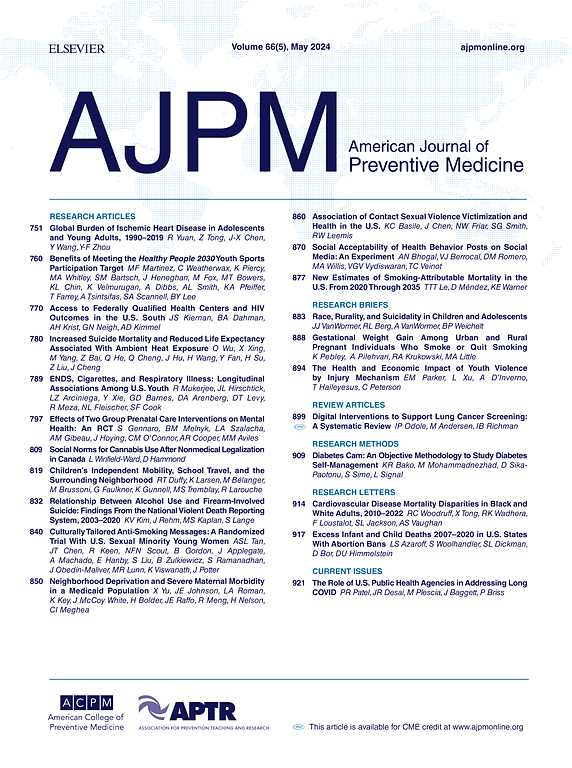以低碳公交为导向的发展和主动交通模式:缓解城市热岛效应和热相关疾病的混合方法研究
IF 4.5
2区 医学
Q1 MEDICINE, GENERAL & INTERNAL
引用次数: 0
摘要
前言:评估低碳交通导向发展(TOD)和主动交通方式(如骑自行车、步行)对人口密集地区城市热岛(UHI)缓解和热相关疾病预防的影响。方法一种混合方法结合了城市地区12个社区的土地利用数据、气象记录和健康调查。热红外成像和地理信息系统(GIS)评估了热岛强度(ΔT = 城乡温差)。通过住院情况(2018-2023)分析了与热有关的疾病发病率(如中暑、脱水)。干预场景使用ENVI-met模型模拟TOD策略(例如,绿色走廊,扩展自行车道)。社区参与调查(n=400名居民)评估了移动模式和热舒适感知的行为转变。结果有TOD基础设施的社区与常规区域相比,温度降低1.8 ~ 2.3°C ΔT (p<0.01)。主动交通使用的增加与热相关住院率降低37%相关(调整后OR=0.63, 95% CI: 0.51-0.78)。绿色走廊的实施使地表温度降低了2.1°C (p<0.05),并提高了行人的热舒适性。调查数据显示,干预后68%的居民采取了降温行为(如补水、遮蔽路线)。将低碳TOD与主动交通相结合可显著降低城市热岛效应和与热相关的疾病风险。这些发现通过促进结合热舒适、减排和公平健康结果的城市设计来支持预防性公共卫生战略。决策者应优先考虑tod扩展的绿色空间和安全的自行车网络,以减轻弱势群体的气候健康协同效应。本文章由计算机程序翻译,如有差异,请以英文原文为准。
Low-Carbon Transit-Oriented Development and Active Transportation Modes: A Mixed-Methods Study on Mitigating Urban Heat Island Effects and Heat-Related Diseases
Introduction
To evaluate the impact of low-carbon transit-oriented development (TOD) and active transportation modes (e.g., cycling, walking) on urban heat island (UHI) mitigation and the prevention of heat-related diseases in densely populated areas.
Method
A mixed-methods approach combined land use data, meteorological records, and health surveys across 12 neighborhoods in a metropolitan area. Thermal infrared imaging and geographic information systems (GIS) assessed UHI intensity (ΔT = urban-l rural temperature difference). Heat-related illness incidence (e.g., heatstroke, dehydration) was analyzed via hospital admissions (2018–2023). Intervention scenarios simulated TOD strategies (e.g., green corridors, expanded bike lanes) using ENVI-met modeling. Community engagement surveys (n=400 residents) evaluated behavioral shifts in mobility patterns and thermal comfort perceptions.
Results
Neighborhoods with TOD infrastructure showed 1.8–2.3°C lower ΔT compared to conventional zones (p<0.01). Increased active transportation usage correlated with a 37% reduction in heat-related hospitalizations (adjusted OR=0.63, 95% CI: 0.51–0.78). Green corridor implementation reduced surface temperatures by 2.1°C (p<0.05) and enhanced pedestrian thermal comfort. Survey data indicated 68% of residents adopted heat-mitigating behaviors (e.g., hydration, shaded routes) post-intervention.
Discussion
Integrating low-carbon TOD with active transportation significantly reduces UHI effects and heat-related disease risks. These findings support preventive public health strategies by promoting urban designs that combine thermal comfort, emission reductions, and equitable health outcomes. Policymakers should prioritize TOD-expanded green spaces and safe cycling networks to mitigate climate-health synergies in vulnerable populations.
求助全文
通过发布文献求助,成功后即可免费获取论文全文。
去求助
来源期刊

American Journal of Preventive Medicine
医学-公共卫生、环境卫生与职业卫生
CiteScore
8.60
自引率
1.80%
发文量
395
审稿时长
32 days
期刊介绍:
The American Journal of Preventive Medicine is the official journal of the American College of Preventive Medicine and the Association for Prevention Teaching and Research. It publishes articles in the areas of prevention research, teaching, practice and policy. Original research is published on interventions aimed at the prevention of chronic and acute disease and the promotion of individual and community health.
Of particular emphasis are papers that address the primary and secondary prevention of important clinical, behavioral and public health issues such as injury and violence, infectious disease, women''s health, smoking, sedentary behaviors and physical activity, nutrition, diabetes, obesity, and substance use disorders. Papers also address educational initiatives aimed at improving the ability of health professionals to provide effective clinical prevention and public health services. Papers on health services research pertinent to prevention and public health are also published. The journal also publishes official policy statements from the two co-sponsoring organizations, review articles, media reviews, and editorials. Finally, the journal periodically publishes supplements and special theme issues devoted to areas of current interest to the prevention community.
 求助内容:
求助内容: 应助结果提醒方式:
应助结果提醒方式:


